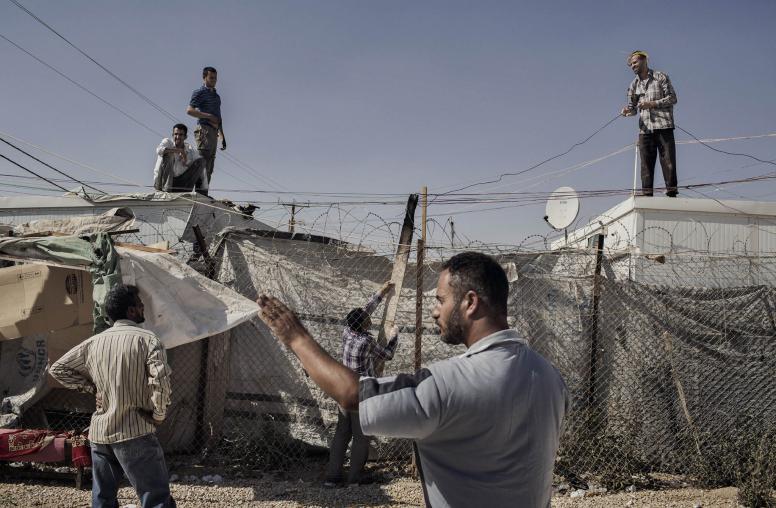Syria's Conflict, In Numbers: 525,600 Minutes X 2
It has been two years since the beginning of the Syrian uprising. USIP Program Officer Rachel Brandenburg counts the ways the country has been shattered and its neighbors overwhelmed.

Five hundred twenty-five thousand
Six hundred minutes
How do you measure, measure a year?
In daylights, in sunsets, in midnights
In cups of coffee
In inches, in miles, in laughter, in strife.
…How do you measure
A year in the life?
– Seasons of Love, written and composed by Jonathan Larson
It has been 2 years since the beginning of the Syrian uprising. On March 16, 2011, 35 people were arrested in Damascus while holding a “Day of Dignity” protest to demand the release of political prisoners. The same day, several protestors at a “Day of Rage” rally in Deraa were shot and killed by Syrian security forces. Days of violent protest followed.
As the late American composer and playwright Jonathan Larson’s lyrics described in an era long before the Syrian rebellion, there are countless ways to measure “a year in the life.” Unfortunately, some of the ways in which we can measure the last 2 years in the life of the Syrian revolution are pretty grim.
1 million people have become refugees, fleeing their country because of the violence since the beginning of the conflict, according to the office of the United Nations High Commissioner for Refugees. That’s more people than the populations of Washington, D.C. and New Orleans, combined.
- These 1 million people include approximately: 236,000 girls. 259,000 boys. 236,000 women. 269,000 men. 50 percent are younger than 18 years old. 38 percent are younger than 12 years old. 18 percent are younger than 5 years old.
- Approximately 125 babies are born as refugees each day.
- At least 332,297 Syrian refugees have fled to Lebanon, a country with a total population of only 4.2 million people.
- Some 324,543 Syrian refugees have fled to Jordan.
- Turkey hosts 185,205 Syrian refugees.
- Iraq has taken in 106,690 Syrian refugees.
- North Africa hosts 51,927 Syrian refugees – at least 43,665 of whom are in Egypt.
- 33,244 Syrians refugees fled to Europe.
In February, Syrians were estimated to be leaving their home country at a rate of 8,275 individuals per day.
Over 2.5 million Syrians have been forced from their homes by the conflict and are still inside the country, according to U.N. estimates.
“Syria is the largest IDP crisis in the world,” Claire Spurrell of the Internal Displacement Monitoring Center told McClatchy Newspapers.
At least 4 million Syrians – almost half the population of New York City – are in need of humanitarian assistance, including 3 million in need of food, according to Colum Lynch, a longtime United Nations correspondent, who wrote a similar account of Syria by the numbers in Foreign Policy in January. The U.N. World Food Programme estimates it will have fed 2.5 million people inside Syria by April 2013. In February, the U.N. children’s agency UNICEF began delivery of water treatment supplies for more than 10 million people -- close to half of Syria’s population.
More than 70,000 lives have been lost in the Syrian conflict, according to UNHCR.
1/5 of Syria’s schools – at least 2,400 - have been physically damaged or destroyed. More than 75 percent of Syria’s schools are now closed due to threat of violence. More than 110 teachers and school staff have been killed. Where kids can’t go to school, particularly in Homs, Deraa, rural Damascus, Tartous, Lattakia, Hama, and Quneitra, UNICEF is supporting more than 170 school clubs that provide remedial education and recreational activities.
34 journalists have been killed in Syria covering the conflict. 28 were killed in 2012, making it the most deadly conflict for journalists to cover. 5 journalists were killed in 2013, as of March 11.
57 percent of Syria’s public hospitals have been damaged or destroyed, according to Syrian authorities’ estimates. 40 percent of ambulances have been damaged. More than 166 tons of medical material has been delivered by Medecins Sans Frontieres across Syria. That’s approximately equal to the weight of 12 yellow American school buses.
More than $1.5 billion have been pledged by the international community to provide humanitarian aid to Syrians, in addition to other assistance funds. The United States contributed $385 million; the UK contributed $220 million; Kuwait contributed $300 million; the United Arab Emirates contributed $300 million; and Saudi Arabia contributed $300 million among other donors. To date, however, only about 25 percent of the funds promised have been received.
By all estimates, the numbers of Syrians in need of humanitarian assistance, fleeing their homes, fleeing Syria, and being killed are rising exponentially and will continue to do so. And many experts say the current numbers are far too low.
There are many other numbers to reflect the past 2 years of Syria’s conflict. Countless Syrian activists are bravely standing up civil society efforts within and outside Syria, and citizen journalists have remained determined to share otherwise unreported stories of the revolution with the world, despite the dangers of doing so.
Although the Assad regime still reigns, and is still officially the sovereign governing authority of the Syrian Arab Republic, the Syrian National Coalition has been widely recognized as the legitimate representative of the Syrian people. In many respects and in many liberated areas, Syria’s transition to new governance has begun.
There are likely to be many more minutes, daylights, sunsets, and miles to count before Syria’s conflict ends. USIP, together with the nongovernmental organization The Day After, based in Istanbul, and its partners will continue to work with Syrian activists and the Syrian Opposition Council in support of their transition.
What numbers have you heard reported about the Syrian conflict over the past 2 years?
Rachel Brandenburg is a USIP Program Officer for Middle East Initiatives who formerly worked in the State Department’s Office of Middle East Transitions.


